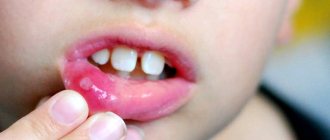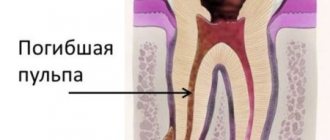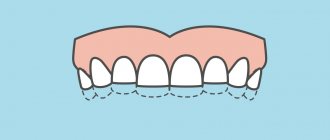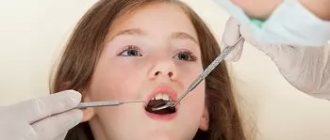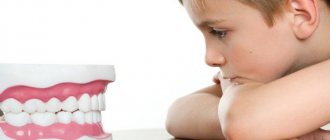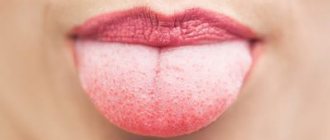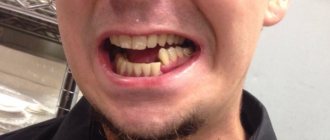Mouth pain is most often caused by infection, allergies, or injury. A sore throat can easily be confused with pain in the mouth.
THE DOCTOR'S CONSULTATION
Contact your doctor if your child:
- refuses to drink for a long time due to pain in the mouth
- he has a mouth ulcer that has not healed for more than a week
- swelling of the gums, lips, palate
ATTENTION!
Pain in the mouth can lead to a child refusing to drink for a long time, and this is dangerous due to the risk of dehydration.
| ASK YOURSELF A QUESTION | POSSIBLE REASON | WHAT TO DO |
| Is your baby breastfed and has small sores on your tongue? | Incorrect attachment during breastfeeding | Ulcers are formed from pressure from the nipple when the baby is not latched onto the breast incorrectly and go away when proper latching is established. Try changing your feeding position. You can contact a lactation consultant for help in establishing proper feeding. If inflammation or other symptoms occur, contact your child's doctor . |
| Has your child's drooling increased? Does he keep his finger(s) in his mouth all the time? Is he 4-8 months old? | Teeth cutting | If these symptoms are accompanied by signs of illness (fever, loss of appetite, etc.), call your child's doctor for an examination. The appearance of teeth alone cannot cause a high temperature. Some children find it easier if they are given special rubber rings to chew on; others like to live cool objects (see Toothache) |
| Is your baby hungry but refusing to nurse? Are there white spots on the tongue and inside of the cheeks? Did he take antibiotics? | Thrush | This is a fungal disease and can be caused by taking antibiotics. Consult your child's doctor . A good remedy is to treat your mouth with a soda solution. Sometimes it is necessary to take antifungal agents. |
| Is your older child complaining of pain when swallowing? | Viral or bacterial (streptococcal) infection | Take your child to the pediatrician . He will prescribe the necessary treatment |
| Do you have small, painful sores on your tongue and inside your cheeks? | Ulcerative stomatitis | Take your child to the pediatrician. He will prescribe the necessary treatment |
| Painful yellowish spots or blisters on the tongue, gums, inner cheeks, swelling and redness of the oral mucosa? Enlarged cervical lymph nodes, “cold” on the lip? Are your lips bright red, swollen, painful? Temperature 37.5-39 C? Loss of appetite, headache, drooling? | Herpetic or other viral infection | Call a doctor and follow all his instructions. A sick child should have separate dishes; isolation is required. Paracetamol will help with pain and fever. Give non-carbonated, non-acidic drinks (water, milk, milkshakes); broths |
| Are your lips dry and bright red? Are there peeling and cracks in the corners of your mouth? | Seizures (cheilitis); may be caused by B vitamin deficiency or food allergies | Talk to your child's doctor . Use hygienic lipstick, baby cream, especially in cold weather |
| Does your child have a constant sore on the tip or edge of his tongue or one sore on the inside of his cheek? | Biting with a tooth | Contact your dentist |
| Does your child have sores on his tongue or on the inside of his cheek? Is he taking any medication, such as an anticonvulsant or an antibiotic? | Possible side effects of the medication | Show your child to the pediatrician - he will recommend what to do |
FOR INFORMATION
"Geographical" language
A healthy tongue is pink in color, its upper surface is covered with papillae surrounded by taste endings. Sometimes parents notice with concern that the child’s tongue is covered with bright red spots with white borders and resembles a map. The spots are painful and appear and disappear. This inflammation of the tongue is the so-called harmless migratory glossitis. It does not require treatment. The reason is not known for certain.
Causes of stomatitis
The imperfection of local and general defenses of the child’s body makes the mucous membranes of the oral cavity vulnerable to adverse factors. And the healthy curiosity characteristic of every child has made stomatitis one of the most common diseases among children. Sometimes, for the development of an illness, it is enough to taste any less than sterile object. The main causes of the disease include the following:
- insufficiently good oral hygiene;
- minor injuries - cheek biting, scratch, etc.;
- burns, including chemical burns;
- exposure to pathogens from unwashed hands or dirty toys.
Dentists focus on stomatitis associated with biting the inside of the cheek.
This is often associated with recent dental treatment under local anesthesia. For some time after the procedure, there is reduced sensitivity in the area of the lip or cheek, so you need to eat food after treatment very carefully and only after you have waited for the recommended period of time - usually from 1 to 2 hours. The likelihood of developing stomatitis for these reasons increases after infectious diseases, previous interventions, hypothermia and other factors that contribute to a decrease in protective forces.
ethnoscience
If a 5-year-old child has a sore cheek, traditional medicine can alleviate the condition. Cold compresses are considered effective, in which ice must be wrapped in a cloth and applied to the sore area. This allows you to relieve discomfort. Instead of ice, you can apply half a raw potato with the cut side to the skin.
Antiseptic rinses with a baking soda solution help. For this, 1 tsp. The product is dissolved in a glass of warm boiled water. Herbal infusions based on chamomile, calendula, green or black tea, oak bark and other herbal infusions have anti-inflammatory and wound-healing effects. Preparation is carried out by brewing 2-3 tbsp. l. raw materials with a liter of boiling water.
Types of stomatitis
The treatment regimen for stomatitis in children is based on the type of disease. There are several types of stomatitis:
- bacterial;
- viral, including herpes;
- fungal;
- aphthous;
- angular;
- allergic;
- traumatic.
All types of stomatitis occur in children, but the most common among children under 3 years of age are aphthous, candidal, herpetic and allergic. An increase in the incidence of traumatic stomatitis is usually associated with a period of active growth of primary teeth.
It is important to understand that in some cases, stomatitis is combined with other diseases with similar symptoms and is the first sign of more serious diseases. For example, with cheilitis - inflammation of the mucous membrane and red border of the lips, food allergies, etc.
Medicines
If a child’s cheek hurts on the inside, then painkillers with ibuprofen (Ibuprofen, Nurofen), paracetamol (Calpol, Panadol), which can also relieve fever during teething, help.
Older children (from 12 years old) are given medications with nimesulide (“Nimesil”, “Nimegesic”). The use of “adult” painkillers (“Analgin”, “Ketanov”) is permitted from the age of 14. But you still need to read the instructions for the medications. And it should be borne in mind that giving a child painkillers without consulting a doctor for more than 3 days is considered dangerous.
During the treatment of wounds in the mouth, ulcers, and inflammations, gels, ointments, and oils are used that have an antiseptic effect and stimulate recovery. These are Acyclovir, Cholisal, Karotolin. Sprays are used - “Ingalipt”, “Miramistin”, as well as balms and solutions intended for rinsing - “Rotokan”, “Vinilin”, “Chlorhexidine”. But it must be borne in mind that these are only temporary measures that cannot replace professional help. Even if it seems that the disease has subsided, you still need to consult a doctor.
Symptoms
Common symptoms of stomatitis are pain, burning, swelling of the mucous membrane and redness, and bad breath. Salivation also changes - it can be excessive or insufficient, with dry mouth. In some cases, there may be an increase in temperature and enlargement of the submandibular lymph nodes.
The types of stomatitis in children and treatment methods differ, as do the specific manifestations. For example, with aphthous stomatitis, only one large ulceration may appear, but with viral stomatitis, inflammation almost always takes the form of numerous elements or a rash merging into one focus.
Candidal stomatitis is characterized by the formation of a white or yellowish cheesy coating. It is easier to recognize traumatic stomatitis because it is preceded by damage or the source of injury is nearby - a chipped tooth or a rough filling.
Teething
If a child's cheek hurts on the inside, this may be a confirmation of teething. During this process, swelling of the gums appears, and maybe fever. Through the translucent gingival tissue, whitish dental units and bluish hematomas can be seen breaking through to the top, which appears during teething. Children become capricious, sleep poorly and refuse to eat.
Painful sensations appear when sharp fangs or molars with a wide chewing surface grow. Pain in the cheeks sometimes occurs in older children, especially during the period of replacement of milk teeth with molars. This phenomenon occurs in almost all children. Parents need to monitor the child’s condition, and if unpleasant symptoms appear, seek help from a doctor.
Diagnostic features
A dentist can detect stomatitis during the first visual examination. But in controversial cases, laboratory tests may be required. Thus, bacterial inflammation may require identification of the causative agent of the disease and its sensitivity to antibiotics. A scraping and/or virological study will help determine the cause of the disease and prescribe appropriate treatment.
If a combination of several ailments with a similar picture is suspected, as well as if the child’s general well-being deteriorates, laboratory tests of blood and urine and consultations with other specialists may be prescribed.
Sometimes stomatitis can be the first manifestation of systemic diseases, general somatic pathology, for example, diabetes mellitus or malignant neoplasms. Therefore, a timely visit to the doctor is extremely important.
Severe pain
Pain can be both moderate and severe. In any case, it causes inconvenience, so it is better to get rid of it as soon as possible. If the pain is severe, it may be due to:
- trigeminal neuralgia;
- temporal tendinitis;
- Ernst syndrome.
When the buccal nerve is inflamed, there is loss of movement of the painful cheek. Much depends on the children and parents themselves. It is important to spend time on hygiene and follow preventive measures.
When visiting a doctor, he first examines the oral cavity. The specialist also asks about complaints and symptoms. Depending on the problem, a referral to a specific specialist may be provided.
Features of treatment
As is often the case with diseases that are at the intersection of several areas of medicine, inflammatory lesions of the oral mucosa are one of the least studied areas of dentistry. Therefore, several specialists can be involved in the treatment of stomatitis in children in the mouth: pediatrician, dentist, dermatologist, immunologist-allergist, otolaryngologist, etc. This is especially convenient when you go to a multidisciplinary clinic.
Self-medication of stomatitis is unacceptable, and although it is now easy to find ready-made treatment regimens and folk recipes, it is important not to experiment with the baby’s health.
Conservative treatment is mainly used, which involves treating the underlying cause of the disease. Your doctor may prescribe the following medications:
- antibacterial drugs (systemic and local in the form of ointments): for bacterial inflammation;
- antiviral agents for herpes and other types of viral stomatitis;
- antifungal drugs for fungal diseases;
- antihistamines - both for allergic origin of stomatitis, and as part of complex therapy to reduce swelling and itching;
- symptomatic drugs - anti-inflammatory, analgesic, antipyretic.
Treatment of candidal stomatitis in infants should be carried out with caution. At the same time, it is important to pay attention to your health; sometimes the cause of such a disease can be insufficient breast hygiene during lactation.
Often, only local remedies are sufficient, but make sure that the entire oral cavity is treated with the rinse - inflammatory agents can be found on the entire surface of the mucous membranes. Healing applications can be used to a limited extent, only on areas of inflammation.
Treatment of stomatitis of any kind in children involves strict adherence to a diet. The diet should be gentle, it is important to avoid salty, spicy, sour foods and drinks, serve the child warm meals, and limit the consumption of sweets.
If traumatic stomatitis occurs, the doctor will prescribe medications to speed up healing. However, it is very important to prevent re-injury. If it was caused by sharp edges of a tooth or filling, this cause should be eliminated. The doctor will suggest grinding off the filling or replacing it, and will also choose the appropriate option for restoring the shape of the crown in case of chips and cracks.
Injuries
When a child’s cheek hurts, it may be due to injury to the oral mucosa or teeth. If no damage is found on the external part, it is possible that the cheek was damaged from the inside by the dentition. Bruises, abrasions, and swelling are noticeable on the inside. Or the mucous membrane and gums may be scratched. Then the wounds will be noticeable. Trauma is considered a common cause of pain, especially if the child is very active.
It also happens that due to an impact, a piece of enamel breaks off and the stem of the tooth breaks. In the latter situation, the tooth may be intact, but slightly loose. These damages are detected upon inspection. You won’t be able to get rid of the problem on your own; you need the help of a dentist. If the child’s cheek not only hurts inside, but also dizziness and nausea are observed, you should urgently call an ambulance. An ambulance is also needed if there is severe bleeding in the mouth.
Prevention of stomatitis
You can reduce the risk of developing stomatitis using the following recommendations:
- regular washing of toys, bottles, pacifiers, breast hygiene if the baby is breastfed;
- general strengthening activities: walks, wet cleaning, a balanced diet, moderate hardening, adherence to a daily routine;
- fighting bad habits of biting nails, pencils, etc.;
- regular dental examinations and timely interventions in case of dental injuries.
The dentists of the Family Doctor clinic treat and prevent stomatitis in children.
Advanced equipment allows us to quickly and accurately assess the condition of the oral cavity and perform the necessary studies in a short time. We practice modern approaches to the treatment of inflammatory diseases of the oral cavity and adhere to an individual approach to each small patient. Consultations with a pediatric dentist are available by appointment. To make an appointment, call the single contact center or fill out a special online appointment form with a pediatric dentist on the website, or you can also visit the clinic’s reception in person.
Help
When a child’s cheek hurts, what should you do? If you have not yet been examined by a doctor, without a diagnosis and prescription of therapy, assistance must be carried out carefully. We must not allow the pathology to worsen. And for this it is prohibited:
- unauthorized use of antibiotics and other drugs that are sold in pharmacies only with medical prescriptions;
- perform warming up using lamps and warm compresses;
- give your child sweets and solid foods;
- feed cold or hot foods, give sweet, sour, fizzy drinks.
First aid can be performed using pharmaceutical drugs and traditional methods. They will improve the child’s condition, but then you still need to visit a doctor.
Dentists' recommendations
Dentists may advise following simple rules to prevent cheek pain:
- Do not use hot compresses.
- Do not self-medicate.
- If your cheek is swollen, you should not disturb it. At this time, you should not eat very hot or cold foods, nuts, spicy foods, or toffees.
- You should not self-prescribe antibiotics.
You should not delay treatment, especially if a tumor appears. If it increases, then this is considered a sign of the development of a purulent process in the cheek. In the absence of professional help, the situation can only worsen.
